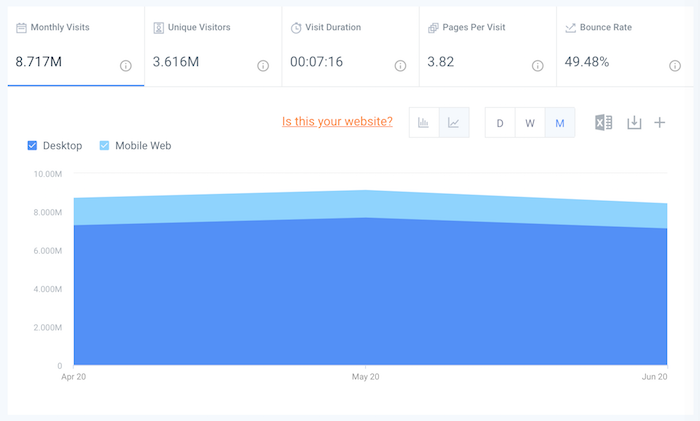
When I first started out in marketing, I thought traffic was everything.
I wanted to be as big as companies like HubSpot. Just look at the image above and you’ll see how many visitors they are getting.
They generate 29.61 million visitors a month from 11.74 million people. And those visitors produce roughly 10 billion dollars of market cap.
Now, let’s look at NeilPatel.com. Can you guess how many visitors I’m getting each month?

I’m generating roughly 8.717 million visitors a month from 3.616 million people.
When you look at it from a unique visitor perspective, HubSpot is getting 3.24 times more unique visitors than me.
So, in theory, I should be worth roughly 3 times less than them, right? Well, technically I’m not even worth 1/10th of them. Not even close.
Why is that? It’s because I didn’t go after the right target audience, while HubSpot did.
And today, I want you to avoid making this massive mistake that I made. Because marketing is tough, so why would you start off by going after the wrong people?
It will just cause you to waste years and tons of money like it did with me.
Defining your target audience is the first and most essential step towards success for any company or business, especially if you are just getting started.
So before we dive into things, let me first break down what you are about to learn in this article:
- What is a Target Audience?
- The Difference Between Target Audience and Persona
- The Importance of Selecting Your Target Audience Correctly
- How to Define your Target Audience: 6 Questions to Help You
- Creating Customized Content for Your Audience
Let’s get started!
What is a target audience?
A target audience is a share of consumers that companies or businesses direct their marketing actions to drive awareness of their products or services.
I know that is a tongue twister, so let me simplify it a bit more…
The intention here is to target a market with whom you will communicate with. A group of people with the same level of education, goals, interests, problems, etc. that will need the product or service you are selling.
Basically, you want to target people who will buy your stuff.
If you target people who don’t want to buy your stuff, you might get more traffic to your site… but it won’t do much for you. And you’ll be pulling out your hair trying to figure out why none of your visitors are buying from you.
Now before we dive into the details on finding your target audience, let’s first go over “personas” because many people confuse them with a target audience and if you do, you’ll just end up wasting time.
The difference between a target audience and a persona
You already know the definition, so I won’t bore you with that again.
The most commonly used data to define the target audience of a company are:
- Age
- Gender
- Education background
- Purchasing power
- Social class
- Location
- Consumption habits
Examples of a target audience: Women, 20-30 years old, living in Los Angeles, with a bachelor’s degree, monthly income of $4,000 – $6,000, and passionate about fashion and decor.
If you start a company without knowing your exact target audience, you could end up like me instead of HubSpot… we wouldn’t want that now.
source https://neilpatel.com/blog/target-audience/
No comments:
Post a Comment